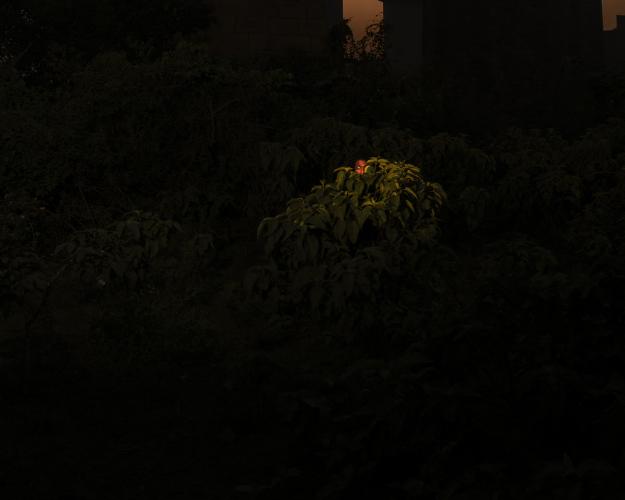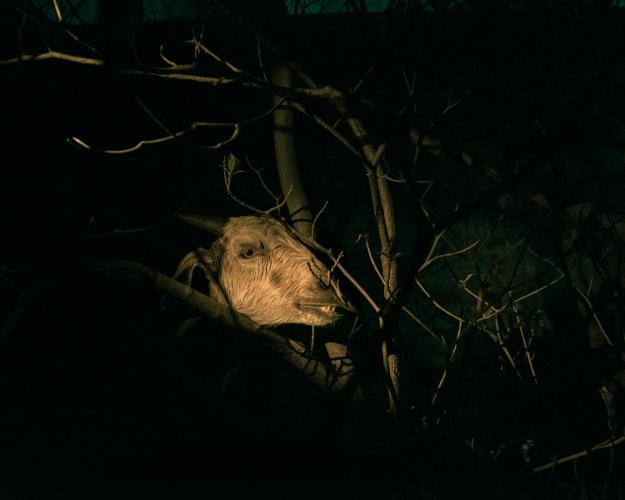(Dis)Embarking Across Time: A Conversation with Soumya Sankar Bose
In this continuing conversation with Soumya Sankar Bose, the artist discusses the concerns that drive his practice, experimenting with virtual reality (VR) and the exhibition site as it transforms both the viewer and the artist. A Discreet Exit through Darkness (2020–Ongoing) was recently exhibited at Experimenter Gallery, Mumbai and Kolkata, and was shortlisted for the Discovery Award supported by the Louis Roederer Foundation. The project is currently on view at Les Rencontres d’Arles as a part of the award show curated by Tanvi Mishra.
Annalisa Mansukhani (AM): Your engagement with fiction and storytelling has endured across your photographic practice. Do you feel like this is a format you are rethinking as you work?
Soumya Sankar Bose (SSB): To me, this project holds immense significance. It represents a very personal exploration that is driven by an intertwining of the real and the fictional. When I engage in storytelling and begin visualising narratives, I am instinctively drawn to what is missing or what is absent. In instances where there is no pre-existing archive, my aim is to create an alternative archive—not an exact replica, but something that serves as an alternative representation.
For instance, we had very few images of my grandfather at our disposal. Consequently, I initiated a series of auditions for the voiceover in the film, searching for individuals whose voices could potentially match the tone and essence of my grandmother's recollections. This process involved a blend of fiction and a quest to recreate the incident as faithfully as possible. Through a careful selection, I aimed to bridge the gap and bring the incident to life, filling in the missing pieces and striving to capture the essence of what truly transpired. In essence, this endeavour is a voyage towards creating a tangible connection to the heart of the story.

AM: Why did you choose to work with virtual reality for this project? Was there a specific kind of mediation you wanted to recreate for your viewers, for the way the work—and the memory of this incident—would come to be experienced?
SSB: The idea for a single-channel 360° VR non-animated feature-length film initially came to me while I was scripting the fictional diary from my grandfather’s perspective. It struck me that I wanted to create an experience where viewers could embark on a journey through time using grainy, dark footage captured by a low-megapixel handycam. The aim was to achieve an immersive effect, making the viewers feel as though they were truly present and travelling alongside the unfolding events.
When I undertake a project, it always revolves around presenting different perspectives of the same incident. I am not a firsthand witness to these events, so I have to rely solely on the memories and recollections shared by others. Moreover, with the passage of time, memories evolve and change, becoming shaped by how we choose to convey them and make them captivating enough for others. Even within families, the perspective of a shared life can vary, despite occupying the same space and existing within the same timeline. Our perception of time will always differ.
The utilisation of a 360° format in this project proved immensely helpful, as it allowed viewers to explore and witness the incident from any angle. However, there is a perpetual sense of something elusive, as every time individuals remove their Oculus headsets, they feel they might have missed certain details. Yet, I assure them that they have not missed anything; they have simply seen what they saw. The next time they view it, they will encounter a different angle, unveiling new facets of the story. This dynamic aspect fascinated me and influenced how I conceptualised and brought this story to life. During y conversations with people, I discovered that they recounted their involvement in helping the police rescue my mother. It is intriguing to observe how one story can be narrated from multiple perspectives, each providing unique insights.
As an artist, public speaking makes me somewhat uncomfortable due to my social anxiety. The 360° format, however, alleviated this challenge by constantly shifting the narrator's position within the narrative. The film comprises numerous layers, infusing it with a deeply personal essence. Moreover, this specific mode of storytelling offers a distinct way of perceiving and experiencing the story. What viewers witness onscreen is similar to a dream-like reality, something they observe but cannot physically grasp. It is akin to two individuals sharing the same dream and subsequently discussing it, but they can never truly see the dream in its entirety together. The vantage point will always remain unique to each individual. These are just a few of the reasons why the 360° format proved to be instrumental in conveying and enriching this story.
AM: Were there any photographic, moving image or literary works that you referred to or used as inspiration for this project?
SSB: When it came to creating the single-channel 360° VR film, we faced a unique challenge. We lacked any specific references for feature-length films in the 360-degree format, whether they were short films, documentaries or even animated films. Our research yielded no substantial findings in this regard.
However, despite this lack of existing examples, we explored innovative avenues to enhance the film. One notable aspect is the inclusion of a radio within the narrative. This radio broadcasts various types of news, drawn from the writings of Subimal Mishra, such as excerpts from his short stories, novels and other literary works. As a devoted fan, I found his writing to be exceptionally captivating and chose to integrate his works into the film, intertwining them with the story I was conveying. Mishra drew inspiration from newspapers and everyday life, which added an intriguing layer of realism to the narrative. During the course of developing my story, I had the privilege of meeting him before his passing in January this year. His presence and guidance provided me with the courage to pursue a creative endeavour, even when faced with seemingly insurmountable challenges. He played a pivotal role in shaping the film in the unique manner in which it exists today.

AM: The exhibition of your work recently concluded at Experimenter and now it travels to Arles. What do you feel each site has or might have to offer to the displays? How do you feel the change in setting will influence the manner in which the work is viewed?
SSB: I believe that it is crucial for artists to experiment with different settings for their work. Personally, I embrace the mistakes I make along the way, as they often contribute to the unique perspective of each piece. In this case, I anticipate that the story will unfold with distinct textures and nuances in Arles as compared to the exhibition at Experimenter Kolkata.
For example, during the exhibition at Experimenter, we had designated time slots for viewing the film, allowing viewers to experience it individually. I believe that exhibitions should not remain static in every iteration; they should evolve alongside the changing character of the artwork and the locations they inhabit. Just as I encounter new people and evolve, the work also undergoes shifts as it encounters new audiences and settings. Each interaction brings forth a fresh dynamic, offering a unique experience for both the viewers and myself.
In case you missed the first part of the conversation, you can read it here.
To read more about Soumya Sankar Bose’s practice, please revisit the artist’s walkthrough of his show Where the Birds Never Sing at Experimenter Gallery, Kolkata and Annalisa Mansukhani’s critical reflection on the project.
All works by Soumya Sankar Bose from A Discreet Exit through Darkness (2020–Ongoing). Inkjet print on archival paper, mounted on dibond. Single channel 360/VR Film, 51 min 17 sec. Images courtesy of the artist.




